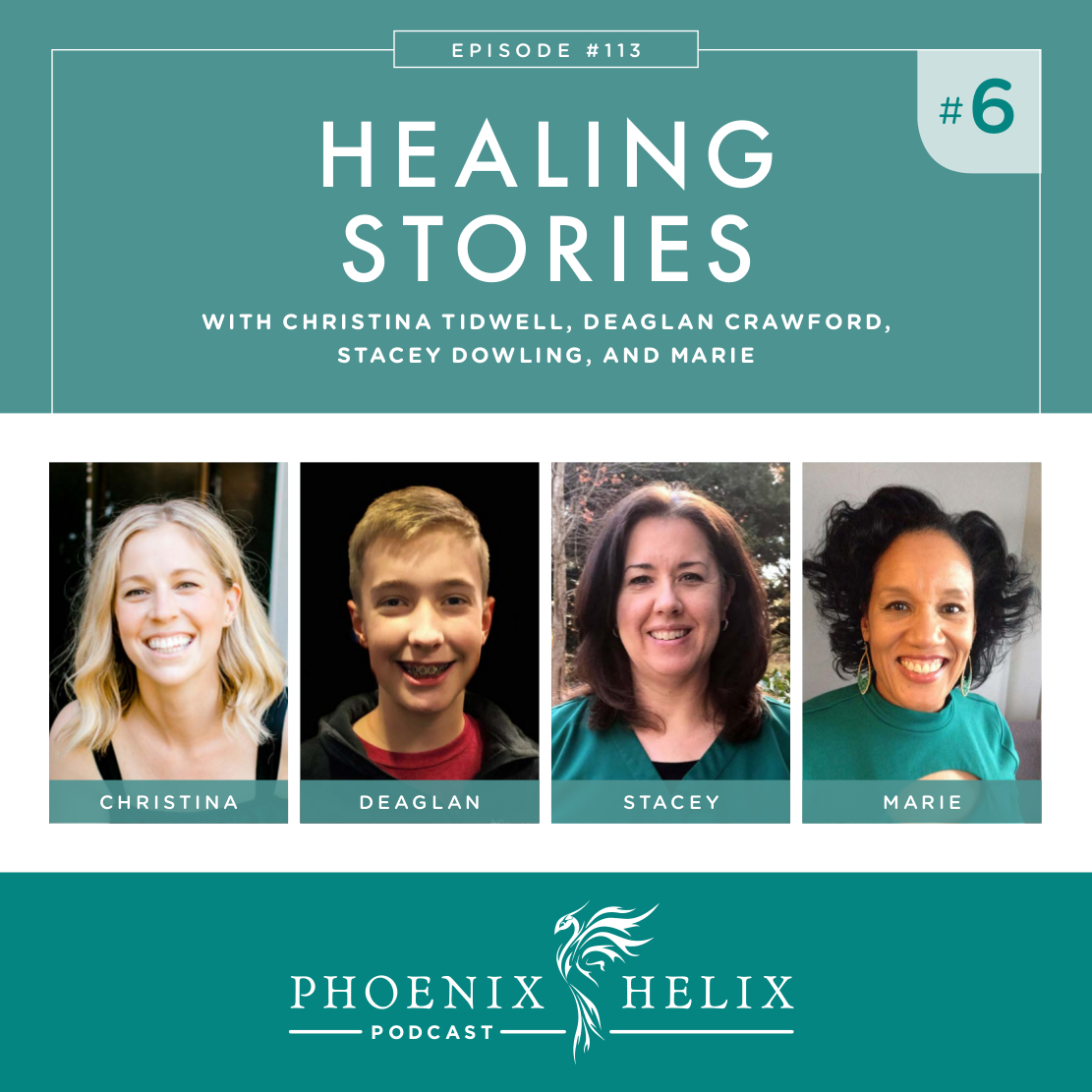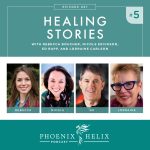Real-Life Stories of Reclaiming Autoimmune Health
If you’re a regular listener of my podcast, you know that I start every year with a Healing Stories episode. It features back-to-back interviews with autoimmune warriors just like you! I ask them to share their journey from rock bottom to reclaiming a vital life. In this episode, we talk about psoriasis, psoriatic arthritis, Crohn’s Disease, Hashimoto’s thyroiditis, AOSD, and also autoimmunity in general. Everyone’s story is unique, but we also have so much in common. Whatever your diagnosis, I hope these stories resonate and inspire.
Listen to the Show
- Subscribe to my podcast through your favorite podcast app: iTunes, Stitcher, Google, TuneIn, Spotify, Amazon, etc.
- You can also listen to the episode right here through the player below, and if you subscribe to my newsletter you’ll get notified of future episodes.
Podcast: Play in new window | Download
Show Notes
- Intro (0:00)
- Thank You to our Podcast Sponsor – Paleo on the Go (1:34)
- A frozen meal delivery service, 100% of their menu is compliant with the elimination phase of the paleo autoimmune protocol (AIP). They have over 5o items, including entrees, side dishes, broth, AIP-friendly bacon, and desserts.
- Use the code PHOENIX for 10% off your first order.
- Christina’s Healing Story (2:38)
- Christina Tidwell has Adult Onset Stills Disease (AOSD), a rare auto-inflammatory condition that impacts the entire body. It’s characterized by high spiking fevers, a rash, sore throat, and joint pain. The fevers are the hallmark symptom and often begin in the evening and improve in the morning, following the body’s circadian rhythms. Stills disease can be a one-time occurrence or a chronic condition.
- She was 18 when she was diagnosed. She’s 31 years old now. When her symptoms first appeared, she thought she just had the flu, but the fevers continued nightly for two weeks. Simultaneously, she got a blood clot in her lungs which sent her to the hospital. After 3 weeks in the hospital and numerous tests, she was diagnosed with AOSD.
- Christina’s lowest point was trying to navigate her first year of college after her diagnosis. She wanted to be a normal kid, but she struggled with mysterious symptoms she didn’t understand, as well as medication side effects.
- 2 years after her diagnosis, a nurse practitioner at the rheumatology office asked her a question no other health professional had asked: “You’ve been through a lot. How are you doing with all of this?” When Christina answered, “not well,” the NP offered to change her prescription and also introduced the idea of diet and stress having an impact on her disease. The was the first time Christina realized she might have some power over her symptoms.
- Christina’s first step was to work with a nutritionist to change her diet and support gut health, including eradicating infections that were contributing to her symptoms. Later, the paleo autoimmune protocol helped her personalize her diet, and she finds nutrient-dense foods especially helpful. She also learned she needs more sleep than the average person, and stress management is essential, including scheduling downtime, silence, and meditation. Now, she’s very tuned into her body’s signals and can often prevent a flare by paying attention to the early warning signs. She also feels better on a daily basis – much less inflammation and more vitality.
- Medication decisions: When she was first diagnosed, she took prednisone and methotrexate. They helped control her symptoms somewhat, but also came with side effects. Later, she was prescribed Enbrel which worked better for her. Now, she doesn’t take any medication regularly, but she does use prednisone as needed to address the rare flares that don’t resolve through natural efforts.
- We also discussed how flares are not failures. When it comes to autoimmune healing, the goal is progress not perfection. It is possible to live a vibrant, beautiful life.
- Christina is a holistic health coach, who works with people around the world via Skype. She also hosts the Live Well Podcast.
- Deaglan’s Healing Story (29:53)
- Deaglan Crawford has Crohn’s disease, an autoimmune disease that attacks the gastrointestinal tract. He’s 13 years old and was diagnosed a year ago. His mother Sherri joined us for this interview. She also has rheumatoid arthritis (RA) herself, and they just discovered that Deaglan’s 10 year-old brother has celiac disease.
- Deaglan was rushed to the hospital with extreme side abdominal pain. His mother and the ER doctors thought he had appendicitis, but when the surgeon came in for a consult, she said it was Crohn’s disease. She announced this without warning, which was terrifying for Sherri. Sherri’s brother has Crohn’s disease, so she knew what that diagnosis meant. Further testing confirmed it. He stayed in the hospital until his condition stabilized, but he was still in a lot of pain when he was discharged home. He needed daily morphine and heat therapy to manage the pain.
- Sherri tried to get her family to switch to paleo back in 2012 for general health and fitness, but it didn’t stick; they returned to a Standard American Diet. When Sherri was diagnosed with RA, the family started exploring the paleo autoimmune protocol (AIP). They fully committed to AIP in 2018 after Deaglan’s diagnosis.
- When I asked Deaglan how he felt about going AIP, he said, “I figured it would be better than suffering every day.” He agreed to do it for one month, and it eliminated his pain completely – not only his abdominal pain, but leg aches he’d had for years that they had thought were growing pains. Then he tested going off-diet, and the pain returned. Since then, he’s remained committed, and the rest of the family feels better on this diet as well. At school, his friends are actually jealous of his lunches, and he also has a friend with Crohn’s who follows the Specific Carbohydrate Diet. A lot of his classmates also follow him on Instagram.
- Medication Decisions: Deaglan takes one medication (omeprazole) which combined with the AIP has led to remission. They’re very grateful he was diagnosed quickly, that the diet is so effective, and that they have been able to avoid biologics.
- Advice from Sherri for parents of children with autoimmune disease: be educated, be open, and it’s okay to make dietary changes in baby steps. Even removing processed foods can make a big difference. Do what you can, and make it work for you and your family.
- Medical Studies: AIP and IBD and SCD and Mediterranean Diets.
- You can follow Deaglan on Instagram: @ibdkidwarrior.
- Thank You to Our Podcast Sponsor: ShopAIP (57:27)
- Gelatin and Collagen are healing foods recommended on the paleo autoimmune protocol, because they are building blocks for tissues throughout the body. They help repair leaky gut, support joint health, improve liver function, support weight management, and also strengthen hair, skin, nails, and bone. You can see why they’re recommended! So, what’s the difference between them? Their health benefits are the same, but their use in recipes is quite different. Gelatin has “gelling” properties, so it’s used in recipes like juice jello, homemade gummy candies, and gelatin eggs (used in AIP baking). Collagen doesn’t gel; instead, it dissolves in liquid. So, it’s often added to smoothies as a protein supplement. You can buy both varieties through ShopAIP.
- An online store, where everything sold is compliant with the elimination-phase of the Paleo Autoimmune Protocol. ShopAIP sells a wide variety of products, including protein bars, AIP-friendly spice blends, cooking and baking ingredients, snacks, non-toxic skincare, and more.
- If you’re a first-time customer, use the code PHOENIX for 10% off your order. Purchase here.
- Stacey’s Healing Story (1:00:04)
- Stacey Dowling has celiac disease, psoriasis and psoriatic arthritis. Autoimmune disease sometimes comes in groups. With three or more diagnoses, it’s called Multiple Autoimmune Syndrome.
- All 3 diagnoses came within months of each other when Stacey was in her late thirties, but she had been experiencing symptoms since childhood. Her first symptom was high fatigue. She went from being a child with tons of energy, to one that needed a nap every day after school. Her mother would wake her up for supper and homework, and then she would go back to bed. From that point forward, she suffered pain, fatigue, and the feeling that she simply couldn’t tolerate life the way everyone else could. When she finally got a diagnosis over 20 years later, it was a relief to finally have an explanation and a potential path to feeling better.
- At her worst, she lost all range of motion in her feet and ankles. This meant she couldn’t walk on uneven ground, and had to take stairs in a slow, sideways motion while leaning against the wall for support. She had multiple falls during this time, and every step hurt. The inflammation spread to her knees, hands and wrists, resulting in the need to change jobs. She had been working as an occupational therapist, but was no longer able to do patient care, so moved into management instead. During this time she found all the private places in the hospital where she could steal a moment to cry. She was also a mother of two young children, and it took all of her energy to make it through the work day. By the time she got home, her feet were so inflamed that she couldn’t stand. She would strap ice packs to her feet and spend evenings on the couch. She worried her children would always see her as sickly.
- Stacey went gluten-free after her celiac diagnosis, but her diet still focused on gluten-free processed foods. This improved her mood and mental health, but her psoriatic arthritis symptoms continued to get worse. 3 years later, she learned about the possibility of cross-reactive foods, and since the paleo diet removes most of those, she decided to try paleo. After just 10 days on the paleo diet, she was able to walk down the stairs normally for the first time in 3 years. Shortly thereafter, she went into remission.
- Medication decisions: At diagnosis, Stacey was prescribed methotrexate which had minimal impact on her symptoms. Later, she was prescribed Enbrel which was much more effective. It allowed her to regain a functional life, but she still had pain and stiffness. It was the paleo diet that finally put her into remission. With her doctor’s help, she tapered off her medication and was medication-free for 3 years. Unfortunately, her symptoms returned at that point. She was already eating paleo, so she tried adding the paleo autoimmune protocol. This did alleviate some of her symptoms, but not all. When her joints started to change shape, she made the decision to go back on medication. Now, she combines Humira with the paleo diet and lifestyle to feel her best. Resource Podcast: 48 – Medication Decisions.
- Stacey is also working on changing her default mindset. Autoimmune disease limited her life for so many years, that even when she’s in remission she has anxiety about being able to keep her commitments, especially when life gets busy. Autoimmune disease can impact our lives like a trauma. She’s striving to unlearn seeing illness as the center of her life. Resource Podcasts: Ep. 108 – Trauma & Autoimmunity, Ep. 106 – From Victim to Empowered, Ep. 104 – DNRS.
- Stacey is a member of the AIP Support Group on Facebook, which is a great place for peer-to-peer support.
- Marie’s Healing Story (1:28:26)
- Marie has Hashimoto’s thyroiditis, an autoimmune disease that attacks the thyroid.
- Her lowest point was 2 years ago, when she was bedridden for 3 months and still undiagnosed. She weighed almost 300 pounds, and suffered bodywide pain. Every doctor she saw told her it was a mental health problem, not a physical problem. Research shows that this is a common experience for women – doctors treat women differently than men, often dismissing and disbelieving symptoms. Her doctors also assumed her weight was causing her health problems, rather than potentially being a symptom itself.
- Marie had been gluten-free and sugar-free for years while her health continued to decline. She did some research and decided to try the paleo autoimmune protocol. Her first improvement was being able to sleep through the night after months of severe insomnia. Next, she noticed she could get out of bed in the morning without pain for the first time in years. Within 5 months, she’d lost 70 pounds, much of which was inflammation.
- Because Marie was was so ill when she first started the AIP, she made it as easy as possible with salads and other no-cook recipes. Then, as her symptoms improved and she gained more mobility, she started cooking and focusing on nutrient-density. That led to further improvements in everything from her energy levels and stamina, to the visible health of her hair, skin, and nails.
- When the AIP allowed her to get out of bed, she was determined to find a doctor who could diagnose her. She had a large goiter at the time, which resulted in a referral to a research ENT who did an ultrasound. He saw enough visible thyroid damage to diagnose Hashimoto’s, but her TSH levels were still “normal.” For that reason, he offered no treatment. He told her she would have to wait until her thyroid failed and he would remove it.
- Medication decisions: The AIP made dramatic improvements in her health, but her thyroid was damaged and Marie believed medication could help her remaining symptoms. Since her doctors refused to prescribe any, she sought the help of a naturopath who prescribed natural dessicated thyroid (NDT). It was NDT that stabilized her body temperature, helped her hair grow back, and reduced the goiter so she no longer has neck issues.
- Now, Marie is thriving through a combination of NDT and a personalized AIP (with reintros). She’s lost a total of 100 pounds, and in addition to the improvements noted above, her seasonal allergies and tonsil stones also disappeared.
- Lastly, Marie has found community support and stress management to be essential to her autoimmune health. Her favorite tools to manage stress include guided meditation, music, reading, and learning to say no. As far as community support, she doesn’t know anyone locally following the AIP, but she has found strong support online through the AIP Support Group on Facebook. She credits it with helping her stay committed to a healthy lifestyle, and to be more creative in the kitchen.
- Resource podcasts: Ep. 27 Hashimoto’s and Ep. 194 Thyroid Tests.
- Summary (1:49:05)
- This is the 6th Healing Stories episode, and you can find the others here. I feature a wide variety of diagnoses, but even if your diagnosis isn’t featured, please know that these stories still apply to you. Autoimmune diseases have much in common, which is why they are treated similarly by conventional medicine, and why the paleo autoimmune protocol benefits so many.
- Many of my podcast guests I meet through social media. Be sure to follow me on Instagram and Facebook, to join the conversation.
- Outro (1:50:56)
- Eileen (your podcast host) is the author of multiple books, written to help people thrive with autoimmune disease. Learn more on the Books Page.
- If you like this podcast, follow or subscribe through your favorite podcast app. You can also subscribe to Eileen’s biweekly newsletter.
- Check out the entire archive of podcast episodes.
You May Also Be Interested In
Spreading the Word
If you like the podcast, please leave a positive review in iTunes. It would mean the world to me, and also helps others find the podcast. Here are some quick instructions using your iPhone:
- If you are already subscribed to my podcast: (1) Click the purple podcast icon. (2) At the bottom of the screen, click Library. (3) At the top of the screen, click Shows. (4) Click the Phoenix Helix podcast image. (5) Scroll down the page, and you’ll see Ratings and Reviews. Scroll down a little bit more and click on Write a Review. This will bring up the review screen. Tap 5 stars (if you love the podcast), and then click in the title box, and it will bring up the keyboard. Enter a title and short review. (6) Click Send in the upper right corner. (7) Thank you! Positive reviews give the podcast a higher search ranking in iTunes, helping people find it and letting them know it’s a quality podcast and worth their time to listen.
- If you haven’t subscribed to my podcast: (1) Click the purple podcast icon. (2) In the lower right corner, click the magnifying class. (3) Type Phoenix Helix in the search box. (4) Click the podcast cover in the Show list. (5) If you’d like to subscribe, click the + sign at the top of the screen. (6) To write a review, scroll down the page, and you’ll see Ratings and Reviews. Scroll down a little bit more and click on Write a Review. This will bring up the review screen. Tap 5 stars (if you love the podcast), and then click in the title box, and it will bring up the keyboard. Enter a title and short review. (7) Click Send in the upper right corner. (8) Thank you! Positive reviews give the podcast a higher search ranking in iTunes, helping people find it and letting them know it’s a quality podcast and worth their time to listen.








